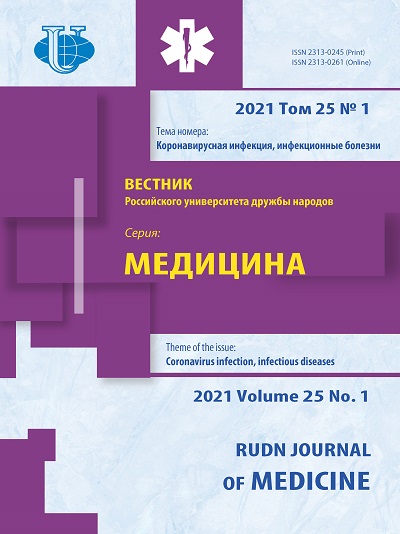Анализ воздействия кофеина и диоксидина на биохимические показатели крови мышей
- Авторы: Дурнова Н.А.1, Шереметьева А.С.1, Каретникова А.Ю.1
-
Учреждения:
- Саратовский государственный медицинский университет им. В.И. Разумовского
- Выпуск: Том 25, № 1 (2021): КОРОНАВИРУСНАЯ ИНФЕКЦИЯ, ИНФЕКЦИОННЫЕ БОЛЕЗНИ
- Страницы: 73-79
- Раздел: ЭКСПЕРИМЕНТАЛЬНАЯ И КЛИНИЧЕСКАЯ ФИЗИОЛОГИЯ
- URL: https://journals.rudn.ru/medicine/article/view/25440
- DOI: https://doi.org/10.22363/2313-0245-2021-25-1-73-79
- ID: 25440
Цитировать
Полный текст
Аннотация
Актуальность . В связи с широким употреблением кофеина важным вопросом является изучение его взаимодействия с веществами, способными проявлять токсический эффект. Цель исследования - оценка степени воздействия кофеина и диоксидина на биохимические показатели крови мышей в тесте вынужденного плавания. Материалы и методы. Исследования были проведены на 6 группах мышей-самцов: контрольной и пяти опытных. Животным группы контроля в течение 15-ти дней эксперимента вводили физиологический раствор, а опытным - кофеин в дозе 40 мг/к или 100 мг/кг (1 и 2), диоксидин в количестве 200 мг/кг (3) и сочетано кофеин и диоксидин (4 и 5). Из биохимических показателей определяли содержание глюкозы, холестерина, мочевины, креатинина, активности аспарагиновой и аланиновой аминотрансфераз. Результаты . Введение кофеина в дозе 40 мг/кг приводило к снижению уровня глюкозы ниже нормы и увеличению концентрации холестерина и мочевины. Применение кофеина в дозе 100 мг/ кг вызывало снижение уровня глюкозы ниже нормы и увеличение концентрации мочевины. При введении диоксидина в дозе 200 мг/кг было отмечено увеличение уровня глюкозы, холестерина, мочевины, а также активности АСТ и АЛТ. Совместное использование кофеина и диоксидина к 15-м суткам приводило к 100 % смертности экспериментальных животных. Выводы . Результаты проведенного эксперимента свидетельствуют о том, что введение кофеина в дозе 40 мг/ кг и 100 мг/кг приводит к увеличению большинства измеряемых показателей относительно контрольных величин, но они не выходят за пределы нормальных значений, однако при этом отмечено снижение уровня глюкозы. Указанные изменения показателей обусловлены преобладанием катаболических процессов над анаболическими. У животных, получавших диоксидин, установлено значительное увеличение концентрации метаболитов и активности ферментов крови, особенно был отмечен рост АСТ и АЛТ, что свидетельствует о преимущественном поражении кардиомиоцитов. Смертность опытных групп, получавших совместно кофеин и диоксидин, к последним суткам эксперимента обусловлена действием чрезмерного стрессового фактора, приводящего к истощению адаптационных возможностей организма и гибели экспериментальных животных.
Ключевые слова
Об авторах
Н. А. Дурнова
Саратовский государственный медицинский университет им. В.И. Разумовского
Автор, ответственный за переписку.
Email: ndurnova@mail.ru
г. Саратов, Российская Федерация
А. С. Шереметьева
Саратовский государственный медицинский университет им. В.И. Разумовского
Email: ndurnova@mail.ru
г. Саратов, Российская Федерация
А. Ю. Каретникова
Саратовский государственный медицинский университет им. В.И. Разумовского
Email: ndurnova@mail.ru
г. Саратов, Российская Федерация
Список литературы
- Reyes C.M., Cornelis M.C. Caffeine in the Diet: Country-Level Consumption and Guidelines // Nutrients. 2018. Vol. 10. № 11. P. 1772. doi: 10.3390/nu10111772
- Ferre S. Mechanisms of the psychostimulant effects of caffeine: implications for substance use disorders // Psychopharmacology. 2016. Vol. 233. № 10. P. 1963-1979. doi: 10.1007/s00213-016- 4212-2
- Jovel C.E., Mejia F.S. Caffeine and headache: specific remarks // Neurologia. 2017. Vol. 32. № 6. P. 394-398. doi: 10.1016/j. nrl.2014.12.016
- Козачук И.В. Влияние кофеина на церебральное кровообращение // Вестник российских университетов. Математика. 2010. Т. 15. № 1. С. 48-50.
- Fulton J.L., Dinas P.C., Carrillo A.E., Edsall J.R., Ryan E.J., Ryan E.J. Impact of Genetic Variability on Physiological Responses to Caffeine in Humans: A Systematic Review // Nutrients. 2018. Vol. 10. № 10. P. 1373. doi: 10.3390/nu10101373
- Калинин А.Я. Кофеин-друг или враг? // Компетентность. 2014. Т. 9. № 120-121. С. 43.
- Верная О.И., Шабатин В.П., Шабатина Т.И., Хватов Д.И., Семенов А.М., Юдина Т.П, и др. Криохимическая модификация диоксидина, его активность и токсичность // Журнал физической химии. 2017. Т. 91. № 2. С. 230-233. doi: 10.7868/ S0044453717020339
- Дурнев А.Д., Кулакова А.В., Жанатаев А.К., Оганесянц Л.А. Оценка цитогенетической и мутаген-модифицирующей активности кофеина в клетках костного мозга мышей // Гигиена и санитария. 2015. Т. 94. № 3. C. 106-110.
- Гарибова Т.Л., Крайнева В.А., Воронина Т.А. Поведенческие экспериментальные модели депрессии // Фармакокинетика и фармакодинамика. 2017. № 3. С 14-19.
- Porsolt R.D., Bertin A., Blavet N., Deniel M., Jalfre M. Immobility induced by forced swimming in rats: effects of agents which modify central catecholamine and serotonin activity // European Journal of Pharmacology. 1979. Vol. 57. № 2-3. P. 201-210.
- Северина Т.Г. Влияние кофеин-бензоата натрия на активность лизосомных ферментов печени и устойчивость крыс к острой иммерсионной гипотермии // Военная медицина. 2009. № 2. Т. 51. С. 110-114.
- Дурнова Н.А., Каретникова А.Ю., Исаев Д.С., Кланцатая А.Р., Шереметьева А.С. Комплексное воздействие кофеина и диоксидина в тесте Порсолта на поведенческие реакции мышей // Вестник Российского университета дружбы народов. Серия: Медицина. 2020. № 4. Т. 24. С. 315-324.
Дополнительные файлы















